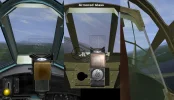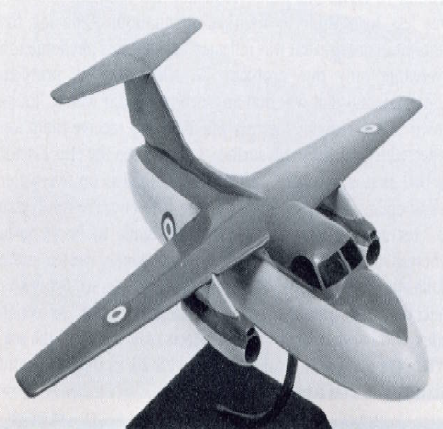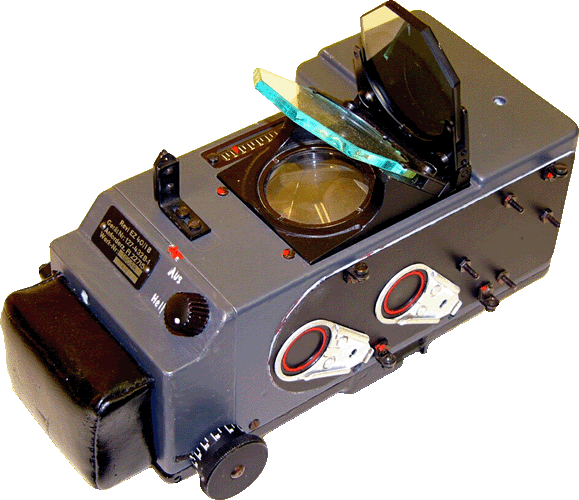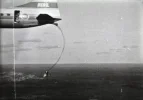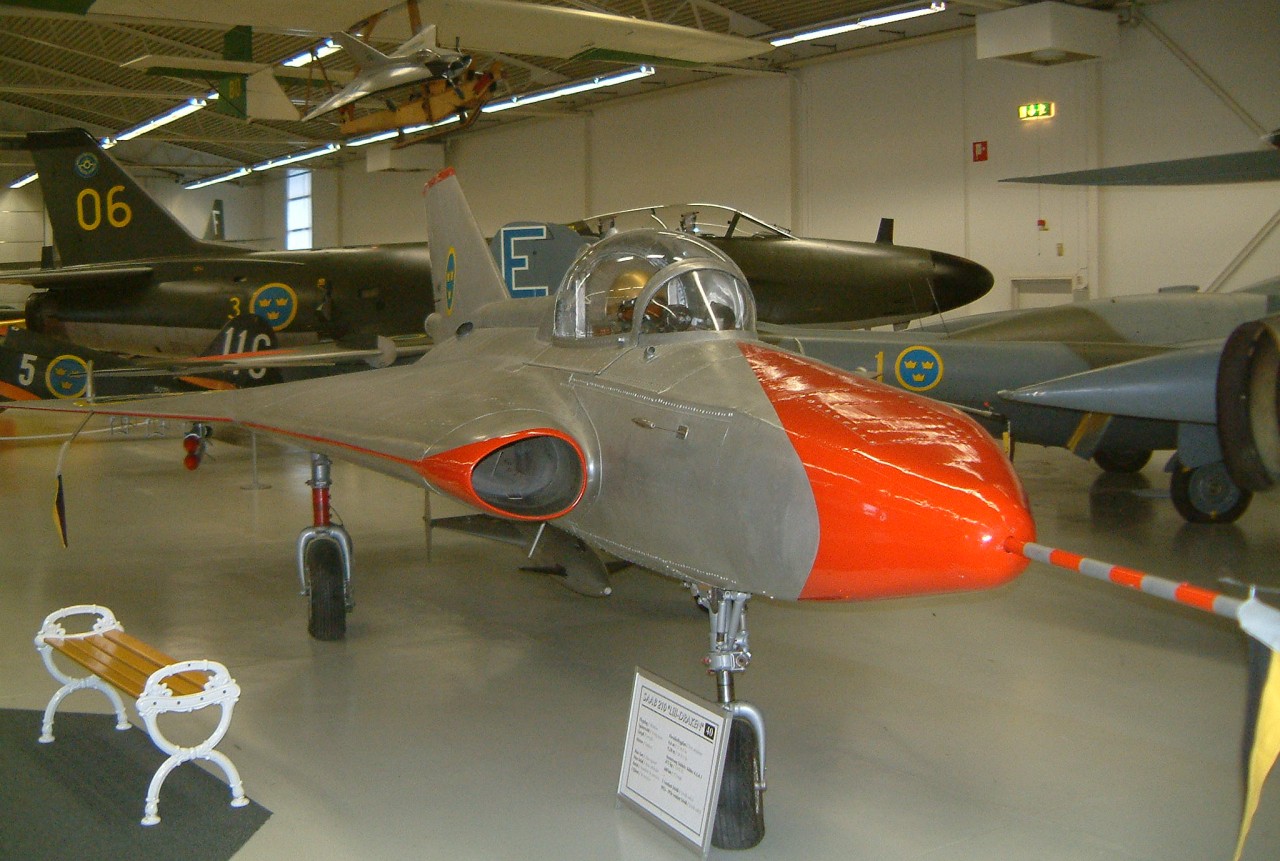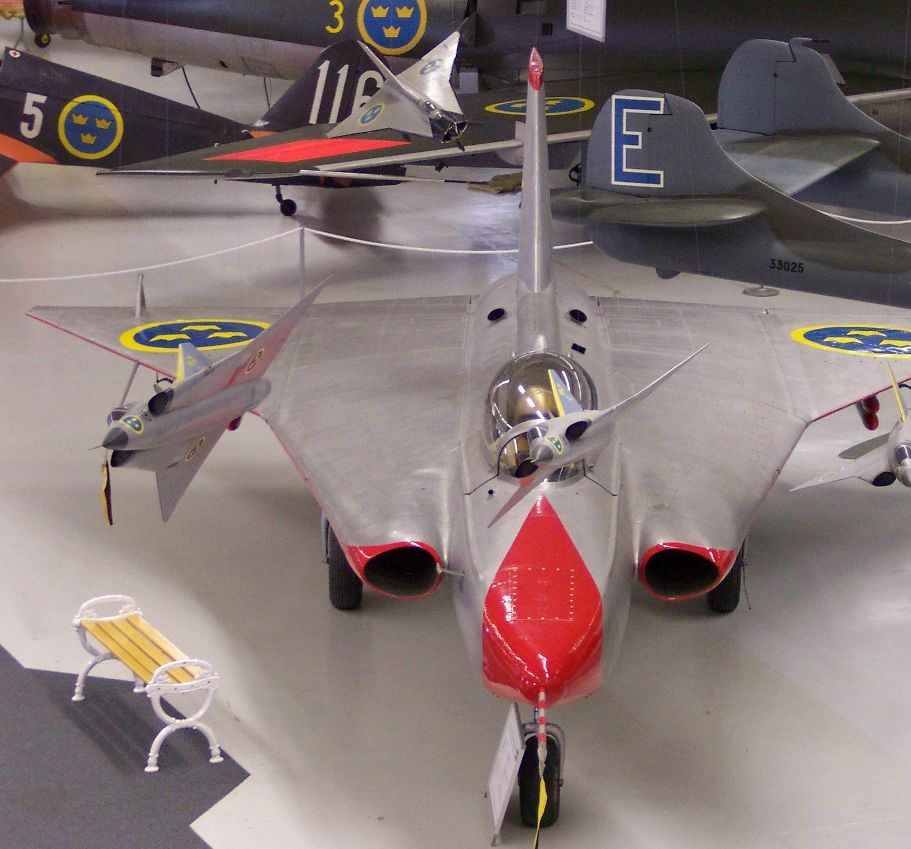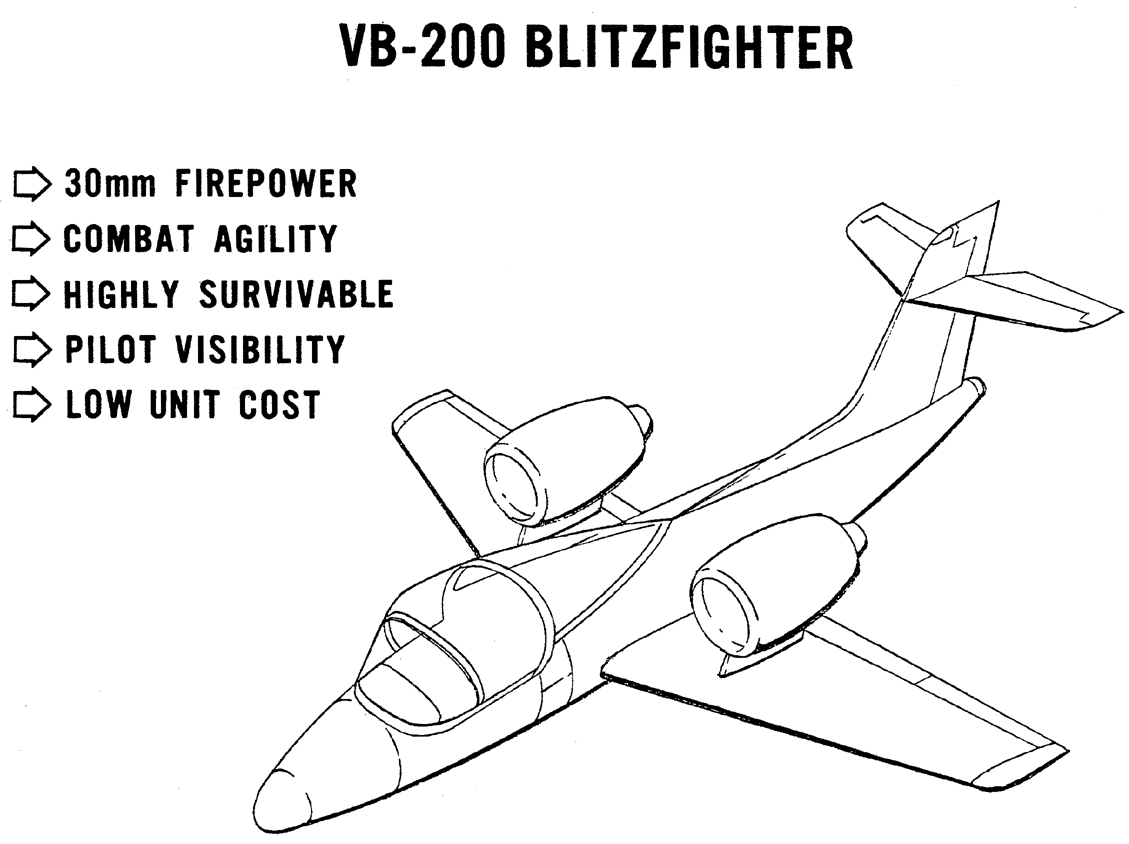Meanwhile, the intelligence community was claiming that the Soviets had adopted the German
blitzkrieg tactics from World War II and would swiftly and easily "
blitz" western Europe if war broke out. (It is no coincidence that the intelligence community began using the term
blitzkrieg after Boyd's briefing became popular.) The Soviets, according to intelligence reports, had a tremendous advantage in numbers of tanks and infantrymen at their disposal. When these superior numbers were combined with
blitzkrieg tactics, the Soviets were portrayed as being almost unbeatable. Exaggerating a threat to justify new wonder weapons was, and still is, a common practice.
The Air Force's answer to this bloated Soviet threat was a new fighter-bomber called the Enhanced Tactical Fighter [ETF], a proposed night all-weather interdiction aircraft. In the view of the Air Force, the word enhanced referred to the new technologies planned for the plane. In my view, it referred to the
costs. This plane was being designed to destroy Soviet tanks deep behind enemy lines and destroy them before they could get to the front and exploit any breakthroughs that would occur (night, all-weather interdiction). The price was a mere
$50 million per airplane.
As it happened, I was putting together my proposal for a new airplane at that time (March 1978). My proposal was exactly the opposite of the $50 million plane. I prepared an advocacy briefing that called for the development of a small, simple, lethal, and relatively cheap airplane that would be designed solely for close support of the ground troops who would be engaged with Soviet tanks and armor. Because the intelligence community was making such a big deal about how difficult it would be to stop the Soviet
blitzkrieg, I named this airplane the "
Blitzfighter". Rather catchy, I thought.
Everything about my proposal, including the plane that would be used, was diametrically opposed to the prevailing philosophy relating to the new wonder weapons of the Air Force. I wanted an airplane in the 5,000- to 10,000-pound class (one-tenth the weight of the Enhanced Tactical Fighter), one smaller than any combat airplane in the inventory (one-fourth the size of the A-10), and one that cost less than $2 million. At this price, we could
flood the battlefield with swarms of airplanes.
The airplane would be designed around a four-barrel version of the same 30mm cannon that was in production on the A-10, which used a seven-barreled cannon that fired shells costing only $13 apiece. This was a far cry from the guided missiles on the Enhanced Tactical Fighter that cost several hundred thousand apiece. The
Blitzfighter would have no high-tech bells and whistles and no wonder weapons. Essentially, it would contain the engine (an existing commercial one), a pilot, a titanium-armored bathtub for the pilot to sit in, a few flight instruments, a radio for the pilot to talk to the ground troops, and a cannon for killing tanks. Nothing more - no radars, infrared sensors, guided missiles, or any of that high-priced junk being installed on every other airplane - was needed.
With the ability to operate from grass fields, the Blitzfighter did not demand fixed, expensive airfields that would probably cease to exist ten minutes after a war started. Squadrons of
Blitzfighters would pack up, move from pasture-to-pasture overnight and follow the flow of battle. Pilots would receive only verbal orders that identified the main points of their effort and left the details of execution to them, a notion that was consistent with Boyd's theories. The plan was in direct contrast to the standard practice of using excruciatingly detailed orders published by higher headquarters for each mission. The orders dictated how much fuel went on board, which weapons were loaded on which wing, the exact route that would be flown to the exact target that had been assigned, and even when the pilot would be allowed to relieve himself. Such rigid orders did not always match up to what was happening in a fast-moving situation.
Finally, the
Blitzfighter would be operated at treetop level so that pilots could use their eyeballs to find tanks that were trying to hide. To survive at this level, the plane had to be extremely agile and dart, twist, turn, accelerate, and decelerate far better than any airplane we had.
I presented this advocacy to General Toomay and asked his permission to make a formal request to our design bureau at Wright Patterson Air Force Base for design studies.
He nearly gagged. He was a high-tech advocate. Everything I was proposing was anti-high-tech. Naturally, we got into an argument.
He said, "
You have to put a radar on the plane; you can't find tanks without a radar."
I responded, "
You can't find tanks with radars; radars can't see through trees, over hills, and when you do see something, you can't tell whether the blob on the scope is a friendly tank, an enemy tank, or a Volkswagen full of refugees; no sir, you can't find tanks with radars."
He said, "
Yes you can."
I said, "
No, you can't," my voice rising.
Then, standing up, he raised his voice, "
Yes you can." General Toomay was a large man, over 6 feet 8 inches tall (His son, Pat Toomay, who took after his father, was a defensive end for the Dallas Cowboys at the time.) At this point, the argument was over. We had been through this routine many times.
Even though he disagreed with me, General Toomay permitted me to proceed without making any changes. He knew my proposal was going to stir up a hornet's nest once the word got out, and he really enjoyed making the system react to unconventional ideas.
I immediately fired off a teletype to John Chuprin, chief of our design bureau at Wright Patterson. John and I performed thousands of design trade-off studies on the lightweight fighters for Boyd a few years before. He and his staff went to work and, within a month, reported back to me that it was entirely feasible to build the airplane I wanted - like I wanted it. He then gave me the preliminary designed for three possible configurations.
Armed with this information, I hit the briefing trail. My intent was to quietly build a network of support at various key agencies within the Air Force and within the Office of the Secretary of Defense before the establishment could react and kill the idea - much the same way the lightweight fighter had been ushered in.
One of the first places I went with my briefing was the A-10 program office at Wright Patterson, where Boyd arranged for me to meet Col. Bob Dilger. Dilger was in charge of producing the 30mm cannon and the ammunition used on the A-10. Because that equipment was such a key part of my proposal, I was anxious to get his reaction.
Dilger was an eccentric character. He was a fighter pilot in Vietnam and was credited with one MIG kill. After firing his radar-guided missiles at his opponent and watching them all miss, he literally ran his opponent into the ground. Bob can be quite aggressive, and he loves a good fight. I liked his style. We quickly became friends. We would join forces a few years later, to discomfort the army.
Dilger was very excited about my proposal and pledged his support. While I was there, he also briefed me on an unusual program he was running. The normal way to test ammunition coming off the production line was to select samples at random and fire them in a laboratory environment to measure muzzle velocity, trajectory, and other factors to determine if they meet the specifications of the contract.
Dilger did it differently. He put some realism into the tests. He scrounged up a bunch of old army tanks and about a half dozen Soviet tanks (T-55s and T-62s), loaded them up with fuel and live ammunition as though they were in combat, and deployed them in typical Soviet tank formations on the Nevada desert. He then talked operational A-10 fighter units into attacking the tanks. Using their combat tactics, they fired Dilger's production line samples of ammunition.
These tests gave pilots valuable training experience. They also revealed, for the first time, major inconsistencies in the computer models that were used to predict the lethality of U.S. weapons. It seems that the test results differed by a factor of two from the model predictions on the lethality of the ammunition. The Soviet tanks were easier to kill than predicted, and the old U.S. tanks were more difficult to kill than predicted. The models were not only off by a factor of two, but they were off in two different directions. This really caught my attention, and I would pursue this subject with great vigor in the years to come.
I next slipped into the Pentagon, and quietly briefed Boyd, Spinney, Christie, and the other rebels in the TAC air shop. It was like preaching to the choir, for this whole crowd had become disenchanted with the direction things were headed in the tactical air forces of all three services.
Boyd arranged for me to meet and brief Pierre Sprey. I heard much about Pierre and was anxious to meet him. He became extremely excited over the
Blitzfighter concept, not just the airplane itself but the whole philosophy and concept of operation. He offered suggestions to improve my briefing and put more bite into it. Pierre is very good with the editing pen, as I would learn in the years to come. He would become my chief editor during my running battle with the army over the Bradley. His pens are shaped like fangs, and his finished product drips with blood, usually Army blood.
Christie then ushered me into a secret meeting with Russell "
Russ" Murray II, director of Program Analysis & Evaluation (PA&E). Murray was the defense secretary's chief analyst. Over the years, this position has been one of great power and influence - one that the secretary has turned to for advice on what weapons systems to buy. That advice, in the past, was usually contrary to the wishes of the services and led to a long-standing adversarial relationship between the director and the various services. In my view, that relationship was healthy, for it sharpened the debate over the appropriate choice of weapons. Under the Reagan administration, unfortunately, the position was completely neutered so that it was no longer a force to be reckoned with.
Russ Murray was receptive and pledged his support if my
Blitzfighter proposal ever officially got to his level, but he doubted that would ever happen. In his view, the Air Force senior leaders would kill the idea as soon as they heard about it. "
The airplane doesn't cost enough," he said. "
They might buy it if you jack the price up two or three times." It turned out that he was correct.
My career suddenly took on a new life. For some strange reason the Air Force promoted my to full colonel after passing me for two straight years. Historically, the chances of being passed over twice is less than 3 percent. General Toomay surprised me one night when he called my home to give me the news. This promotion meant that I would be able to stay in the Air Force for many years to come, rather than leave the service within he next year. (This is known as the "
up or out" policy. Any officer who is passed over three times must leave the service.)
Another promotion was important to my future. My favorite three-star, General Infamous, who had so kindly asked me to leave the Pentagon three years earlier, was promoted to four stars. You guessed it - he was immediately assigned to Air Force Systems Command Headquarters at Andrews. He would again become my boss and General Toomay's. I will never forget the day he arrived. He came to Toomay's office to greet us. In front of the staff, he actually wrapped his arms around me and greeted me like a long-lost brother. I thought to myself, "
What's wrong with this picture?" I soon found out - Within weeks, I was shipped out again.
Meanwhile, Pierre was busy spreading the
Blitzfighter story throughout the defense industry and on Capitol Hill. The concept was stirring up a lot of excitement in the design bureaus of various companies. Early in June 1978, a large group of designers met in a hotel conference room in Springfield, Virginia, about 10 miles south of the Pentagon, to explore the concept in some detail and trade ideas on design approaches. Unfortunately, the press was also there.
Aviation Week ran a two-page story about the conference and treated the
Blitzfighter like it was an officially sanctioned Air Force program. The story cited the design studies that I had asked Wright Patterson to do and even showed sketches of the designs. The Air Force senior leaders were shocked and horrified. The story broke about two weeks after my favorite four-star, General Infamous, had arrived on the scene, and he went ballistic.
Undoubtedly, he got many calls from his fellow four-stars. Like many of them, he was an Enhanced Tactical Fighter advocate, and he was not going to let this
Blitzfighter nonsense continue. He directed that I stop briefing.
I was not even allowed to show him the briefing or explain the concept to him in any fashion. His closed mind had all the answers, and the
Blitzfighter was not one of them. He pronounced to the world that the
Blitzfighter idea was dead, by fiat, and then he arranged for me to be transferred out of his hair - again.
But the
Blitzfighter was not dead. It would raise it's ugly head numerous times during the next few years as one of several symbols of the Reform Movement. Each time it surfaced, the senior leadership went berserk.
My first attempt to "
Make them work for it" came shortly after I returned to the Pentagon in June 1978 as military assistant to Air Force Assistant Secretary for Research, Development, and Logistics Dr. Jack Martin. By law, the Air Force cannot negotiate and sign a contract to produce or develop a weapon system unless it has it's civilian master's signature on a document that permits it to do so. Called a Sectarian Determination & Finding (D&F), that document represents the instrument of control over the military's plans to buy new weapons - no signature, no program.
Dr. Martin, as the acquisition executive for the Air Force, would sign literally hundreds of D&Fs a year. My job was to make sure he knew the implications of what he was signing. Once he had signed, he became an equal partner to the venture (or crime).
I shall never forget that Summer day in 1978 when Brig. Gen. Richard "
Dick" Phillips and his team of briefers marched into the Dr. Martin's office to seek his signature on the D&F for the Air Force's new fighter, the Enhanced Tactical Fighter. The rationale for developing this new airplane was so full of holes and the arguments presented by Phillips were so misleading that
I could not remain silent, as I was expected to do. I must admit that as a newcomer in this arena, I was apprehensive about speaking up, but I did. In the middle of the briefing, I interrupted Phillips and blurted out three questions.
"
What is the mission of this airplane?"
"
Night, all-weather deep interdiction," the answer came back.
"
General, would you give me an example or two from history where deep interdiction has actually influenced the outcome of a battle or campaign?"
The silence was deafening. Phillips scowled at me, but there was no other answer. So I quickly moved on to my last question.
"
Is this airplane going to cost $2 million apiece, or $50 million?"
Answer: "
Well, we don't really know because we haven't gotten that far in the program yet."
I knew this was untrue, because I had talked to the cost analysts at Wright Patterson air force base the day before the meeting. The $2 million figure was a subtle reference to the
Blitzfighter, which was at the other end of the spectrum in both cost and mission.
The meeting broke up in disarray. Dr. Martin asked me to remain as the others filed out. He asked me what was going on since this was the first time I had become an active participant in one of his meetings. I explained to him that the
Air Force was intentionally misleading him on this proposed program, and I gave him names and telephone numbers he could call to confirm if he had any doubt.
Dr. Martin picked up the phone, called Vice Chief of Staff Gen. James Hill, and asked for an immediate private meeting. He then walked next door and handed the unsigned D&F to the Vice Chief, and told him to forget about the program. Who says there is no justice in this world? The mighty Enhanced Tactical Fighter had been shot down in flames by the
Blitzfighter. (During the Reagan administration, the Enhanced Tactical Fighter had been resurrected and put into production.)
Needless to say, General Phillips was not happy with me. I was soon braced up against the wall of the "E" ring. With his forefinger pounding my breastbone like a jackhammer, and his nose about one inch from mine, he let me know that I was dog meat and that several other generals would have a feast when I came back into the "
blue suit" Air Force.
Then, the paranoia surfaced: "
You're not going to ram that F___ing Blitzfighter down our throats like your friends did the F-16!" They were still smarting over that coup.
Although the
Blitzfighter never got off the drawing board, either as a weapon system or a concept, it continually haunted the Air Force senior leadership. As a symbol of the Reform Movement, it would not go away no matter what the generals did. Every time the
Blitzfighter surfaced, the generals went to "
red alert".
Someone on the OSD staff (whose identity is still a mystery to me) had inserted into the Air Force's Fiscal Year 1980 budget the funds and directions for the purchase of
400 F-5E fighters. The F-5 is a small, low-cost fighter version of the T-38 trainer, the plane in which U.S. Air Force pilots learn how to fly. Thousands of F-5s have been sold to Third World countries because they are relatively inexpensive.
The U.S. Air Force, however, considered it a second-rate fighter; it was beneath the dignity of the Air Force to have the plane in it's own inventory. This is the same fighter that had embarrassed the Air Force and Navy in the in mock combat tests in 1977, when it
fought the vaunted F-15 and F-14 to a virtual draw.
When the Air Force leaders saw the F-5E entry in the budget plan, they came unglued. The vice chief of staff called a special meeting with the secretary of the Air Force and all of the civilian and military leaders. (I attended the meeting. The conversations of the participants below are related below in accordance with the best of my memory.)
At the meeting, the vice chief explained to Secretary of the Air Force Dr. Hans Mark that the OSD action was a ruse and that the money was secretly going to pay for the
Blitzfighter, not F-5Es. The vice chief added that this evil act was being perpetrated by the reformers and it had to be stopped.
Dr. Mark asked, "
Who are these Reformers?"
Gen. Jasper Welch, the No.2 man in charge of research and development on the Air Staff, gave a long speech about this gang of rebels and mavericks that gathered every afternoon in the TAC Air Shop. He quickly reviewed the reformers' philosophy and their preference for simple, low-cost weapons instead of the more technically advanced weapons the Air Force prefers. The other generals began their customary round of snide remarks aimed at the reformers and openly chuckled and laughed at the stupidity of the reformers' ideas.
As General Welch began to reel off the names of John Boyd, Pierre Sprey, Chuck Spinney,
Chuck Meyers and the other reformers, Br. Mark interrupted him: "
Wait a minute, I know these guys, and they are very smart people. Maybe we should listen to them."
This was not what the generals wanted to hear. Suddenly, they were no longer interested in getting Dr. Mark involved in stamping out the secret
Blitzfighter raid on their budget. Dr. Mark was a strong-willed, hands-on secretary. When he became involved, things were done his way. Before coming to the Air Force, he had been director of one of NASA's laboratories.
It turns out the generals were all excited over a tempest in a teapot. The reformers had nothing to do with the F-5 showing up in the Air Force's budget. In fact, they were more surprised than the generals. Someone else in OSD placed it there as a lark, simply to make the Air Force mad - which it certainly did. The next time the
Blitzfighter surfaced was for real.
The National Guard is a vital part of the overall defense of the nation. The peacetime relationship between National Guard units, who work for the president, is somewhat fuzzy. National Guard units receive their equipment from the regular forces, that is, the units do not buy their own airplanes. When the Air Force buys new airplanes, it puts them into the active force and sends it's older airplanes to either the National Guard units or the boneyard at Tucson. Whether the boneyard or the National Guard gets the better deal is not clear. Therein lies the rub.
In early 1982, a committee of Army and Air National Guard officers, mostly generals, published a report titled VISTA 1999. This report, which had a definite flavor of "
Alsatian cuisine," called for two unprecedented actions. First, because
the Air Force had, in essence, turned it's back on the concept of close air support, the National Guard wanted to assume the responsibility for that mission for the Department of Defense. Second, the National Guard did not want any more worn-out, hand-me-down aircraft from the Air Force. The repair costs for these old planes were much too high. The National Guard wanted Congress to give it permission and the funds to buy it's own airplanes - and the airplanes it wanted were
Blitzfighters!
This was an act of open rebellion. The National Guard was asking for it's own budget, and permission to spend the money as it saw fit. Charles Mohr, in an article for the
New York Times, stated, "
The report angered and stunned many regular officers and Pentagon officials because of the degree to which the committee accepted major arguments of the 'military reformers'."
When Vice Chief Mathis learned of VISTA 1999, he virtually exploded. The National Guard Bureau, located on the second floor of the Pentagon, was the headquarters of all the guard units. The bureau was run by a two-star National Guard general. According to an aide, when Mathis saw a copy of VISTA 1999, he jumped up from his desk and shouted, "
I'm going down there and punch that general's lights out." He had to be physically restrained by his aides. The battle lines were drawn.
Even though they had old, tired equipment, the Air National Guard units always performed better than the regular Air Force units. At every turn, the National Guard units and their individual pilots were winning fighter competitions against the regular forces. Of course, such victories stuck in the Air Force's collective craw. These victories also added ammunition for the reformers, who publicly argued that pilots' and mechanics' skills were more important than the technological sophistication of a weapons system. With motivated and skilled people, the National Guard units produced superior performance, even though their equipment came from local Air Force thrift shops.
Imagine what they could do with equipment of their own choosing.
When the National Guard stood up and said it was tired of being treated like a poor country cousin, Congress had to listen. Hearings were called. The Air Force scrambled to call in all of it's markers to fight off this unusual and unprecedented request by the National Guard to buy it's own airplane. After a heated debate on Capitol Hill, the Air Force prevailed.
The National Guard, however, did produce some good results through it's efforts. The Air Force began to send the National Guard better equipment, including F-16s and A-10s, instead of worn-out F-4s that were difficult to maintain. Of course, senior Air Force leaders were glad to be rid of what they considered low-end-of-the-spectrum systems. They felt they were "
purifying" the regular force because of the reformers' favoritism for the F-16s and A-10s.
